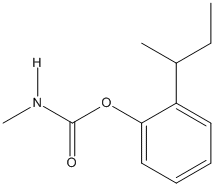Fenobucarb
General
Type : Insecticide,Carbamate
Chemical_Nomenclature : (2-butan-2-ylphenyl) N-methylcarbamate
Canonical SMILES : CCC(C)C1=CC=CC=C1OC(=O)NC
InChI : InChI=1S\/C12H17NO2\/c1-4-9(2)10-7-5-6-8-11(10)15-12(14)13-3\/h5-9H,4H2,1-3H3,(H,13,14)
InChIKey : DIRFUJHNVNOBMY-UHFFFAOYSA-N
Other name(s) : BPMC,Baycarb,Bassa,Barizon,Fenobcarb,Carvil,Hopcin,Osbac,Bayer 41367C,Bayer 41637,Geocarb 50EC,BAY 41637,CHEBI:34304,EINECS 223-188-8,BRN 2052332,AI3-27212,AC1L2EFJ,PS1046_SUPELCO,SCHEMBL73674,45488_RIEDEL,CHEMBL226650,45488_FLUKA,CTK8E4127,MolPort-003-931-168,AKOS015960925,AK129225,LS-50077,TR-015292,FT-0603649,C14425
MW : 207.26
Formula : C12H17NO2
CAS_number : 3766-81-2 || 34681-10-2
PubChem : 19588
UniChem : DIRFUJHNVNOBMY-UHFFFAOYSA-N
IUPHAR :
Wikipedia : Fenobucarb

Target
References (10)
| Title : Assessing joint toxicity of four organophosphate and carbamate insecticides in common carp (Cyprinus carpio) using acetylcholinesterase activity as an endpoint - Wang_2015_Pestic.Biochem.Physiol_122_81 |
| Author(s) : Wang Y , Chen C , Zhao X , Wang Q , Qian Y |
| Ref : Pestic Biochem Physiol , 122 :81 , 2015 |
| Abstract : Wang_2015_Pestic.Biochem.Physiol_122_81 |
| ESTHER : Wang_2015_Pestic.Biochem.Physiol_122_81 |
| PubMedSearch : Wang_2015_Pestic.Biochem.Physiol_122_81 |
| PubMedID: 26071811 |
| Title : The combined toxicity assessment of carp (Cyprinus carpio) acetylcholinesterase activity by binary mixtures of chlorpyrifos and four other insecticides - Chen_2014_Ecotoxicology_23_221 |
| Author(s) : Chen C , Wang Y , Zhao X , Wang Q , Qian Y |
| Ref : Ecotoxicology , 23 :221 , 2014 |
| Abstract : Chen_2014_Ecotoxicology_23_221 |
| ESTHER : Chen_2014_Ecotoxicology_23_221 |
| PubMedSearch : Chen_2014_Ecotoxicology_23_221 |
| PubMedID: 24363216 |
| Title : Pesticide-contaminated feeds in integrated grass carp aquaculture: toxicology and bioaccumulation - Pucher_2014_Dis.Aquat.Organ_108_137 |
| Author(s) : Pucher J , Gut T , Mayrhofer R , El-Matbouli M , Viet PH , Ngoc NT , Lamers M , Streck T , Focken U |
| Ref : Dis Aquat Organ , 108 :137 , 2014 |
| Abstract : Pucher_2014_Dis.Aquat.Organ_108_137 |
| ESTHER : Pucher_2014_Dis.Aquat.Organ_108_137 |
| PubMedSearch : Pucher_2014_Dis.Aquat.Organ_108_137 |
| PubMedID: 24553419 |
| Title : Identification of two acetylcholinesterases in Pardosa pseudoannulata and the sensitivity to insecticides - Zhang_2014_Insect.Biochem.Mol.Biol_46C_25 |
| Author(s) : Zhang Y , Shao Y , Jiang F , Li J , Liu Z |
| Ref : Insect Biochemistry & Molecular Biology , 46C :25 , 2014 |
| Abstract : Zhang_2014_Insect.Biochem.Mol.Biol_46C_25 |
| ESTHER : Zhang_2014_Insect.Biochem.Mol.Biol_46C_25 |
| PubMedSearch : Zhang_2014_Insect.Biochem.Mol.Biol_46C_25 |
| PubMedID: 24463359 |
| Gene_locus related to this paper: 9arac-v5qqc6 , 9arac-v5qqr1 |
| Title : Sensitivity difference to insecticides of a riverine caddisfly, Cheumatopsyche brevilineata (Trichoptera: Hydropsychidae), depending on the larval stages and strains - Yokoyama_2009_J.Pestic.Sci_34_21 |
| Author(s) : Yokoyama A , Ohtsu K , Iwafune T , Nagai T , Ishihara S , Kobara Y , Horio T , Endo S |
| Ref : Journal of Pesticide Science , 34 :21 , 2009 |
| Abstract : Yokoyama_2009_J.Pestic.Sci_34_21 |
| ESTHER : Yokoyama_2009_J.Pestic.Sci_34_21 |
| PubMedSearch : Yokoyama_2009_J.Pestic.Sci_34_21 |
| PubMedID: |
| Title : Dynamics of esterase alleles in Culex pipiens complex mosquitoes in Beijing - Yan_2008_J.Econ.Entomol_101_1897 |
| Author(s) : Yan S , Wu Z , Cui F , Zhao Q , Qiao C |
| Ref : J Econ Entomol , 101 :1897 , 2008 |
| Abstract : Yan_2008_J.Econ.Entomol_101_1897 |
| ESTHER : Yan_2008_J.Econ.Entomol_101_1897 |
| PubMedSearch : Yan_2008_J.Econ.Entomol_101_1897 |
| PubMedID: 19133472 |
| Title : Filariasis vector in China: insecticide resistance and population structure of mosquito Culex pipiens complex - Cui_2007_Pest.Manag.Sci_63_453 |
| Author(s) : Cui F , Tan Y , Qiao C-L |
| Ref : Pest Manag Sci , 63 :453 , 2007 |
| Abstract : Cui_2007_Pest.Manag.Sci_63_453 |
| ESTHER : Cui_2007_Pest.Manag.Sci_63_453 |
| PubMedSearch : Cui_2007_Pest.Manag.Sci_63_453 |
| PubMedID: 17387711 |
| Title : Application of dual counter-current chromatography for rapid sample preparation of N-methylcarbamate pesticides in vegetable oil and citrus fruit - Ito_2006_J.Chromatogr.A_1108_20 |
| Author(s) : Ito Y , Goto T , Yamada S , Matsumoto H , Oka H , Takahashi N , Nakazawa H , Nagase H |
| Ref : Journal of Chromatography A , 1108 :20 , 2006 |
| Abstract : Ito_2006_J.Chromatogr.A_1108_20 |
| ESTHER : Ito_2006_J.Chromatogr.A_1108_20 |
| PubMedSearch : Ito_2006_J.Chromatogr.A_1108_20 |
| PubMedID: 16445929 |
| Title : Sensitivity of brain cholinesterase activity to diazinon (BASUDIN 50EC) and fenobucarb (BASSA 50EC) insecticides in the air-breathing fish Channa striata (Bloch, 1793) - Van Cong_2006_Environ.Toxicol.Chem_25_1418 |
| Author(s) : Van Cong N , Phuong NT , Bayley M |
| Ref : Environ Toxicol Chem , 25 :1418 , 2006 |
| Abstract : Van Cong_2006_Environ.Toxicol.Chem_25_1418 |
| ESTHER : Van Cong_2006_Environ.Toxicol.Chem_25_1418 |
| PubMedSearch : Van Cong_2006_Environ.Toxicol.Chem_25_1418 |
| PubMedID: 16704077 |
| Title : Effect of Long-Term Successive Applications of Organic Fertilizers on Dissipation of Several Pesticides in Two Soils - Suzuki_2004_J.Pestic.Sci_29_33 |
| Author(s) : Suzuki S , Otani T |
| Ref : Journal of Pesticide Science , 29 :33 , 2004 |
| Abstract : Suzuki_2004_J.Pestic.Sci_29_33 |
| ESTHER : Suzuki_2004_J.Pestic.Sci_29_33 |
| PubMedSearch : Suzuki_2004_J.Pestic.Sci_29_33 |
| PubMedID: |